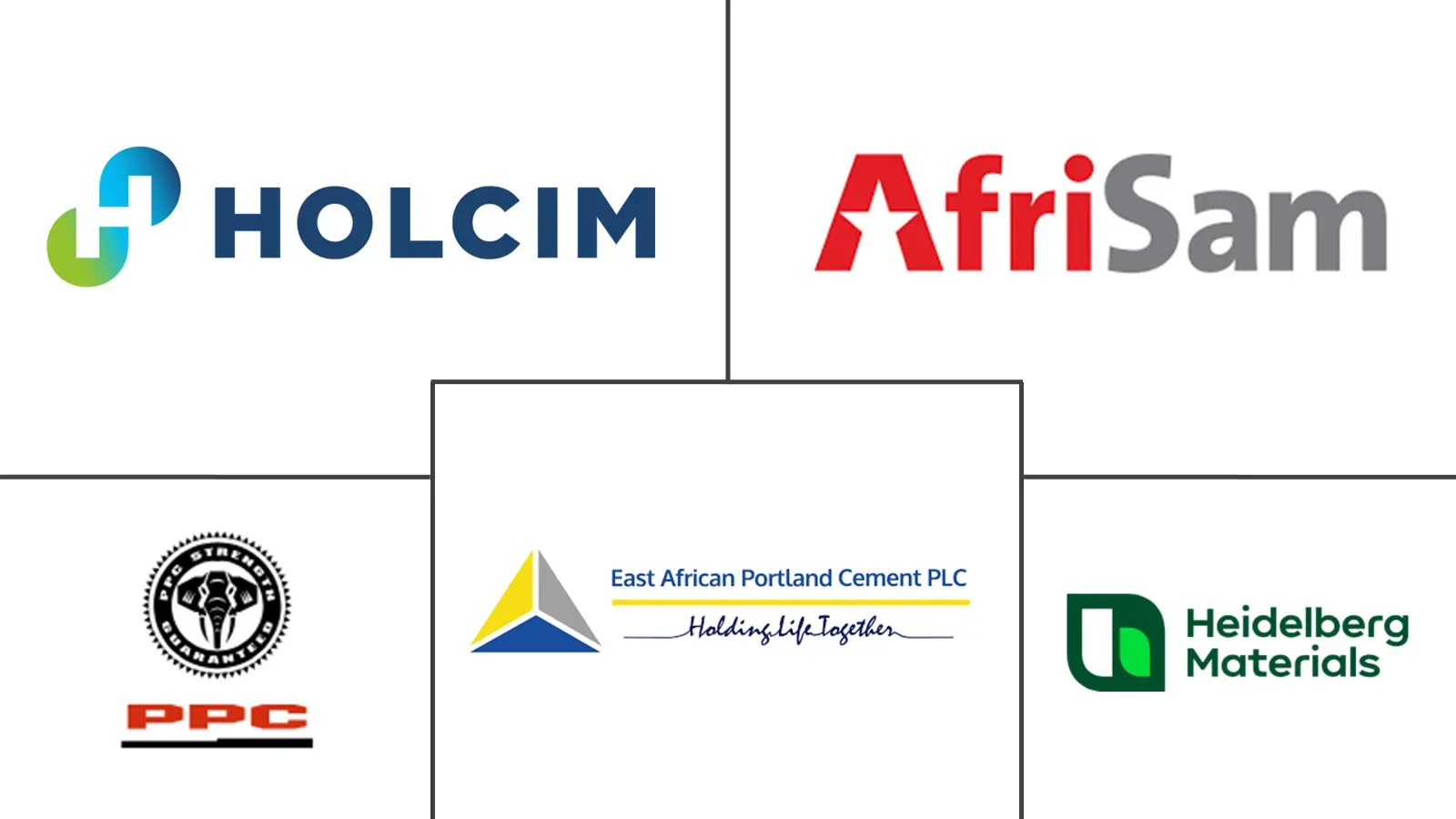Africa Green Cement Market Size and Share
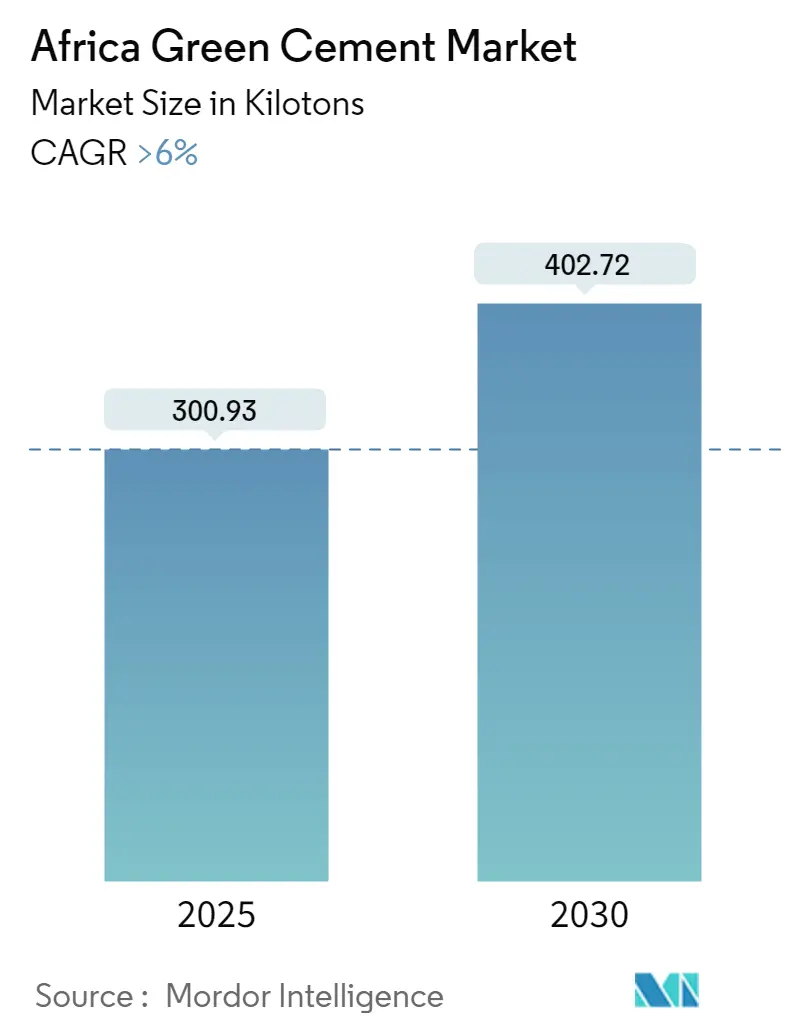
Africa Green Cement Market Analysis by Mordor Intelligence
The Africa Green Cement Market size is estimated at 300.93 kilotons in 2025, and is expected to reach 402.72 kilotons by 2030, at a CAGR of greater than 6% during the forecast period (2025-2030).
The outbreak of the COVID-19 pandemic in 2020 slowed construction and building activities in Africa, leading to decreased demand for green cement. The pandemic made the governments impose travel restrictions and other regulations that caused challenges such as disruption in the supply chain and low demand. However, the conditions started recovering in 2021, restoring the market's growth.
Over the short term, growing construction projects in major African economies like South Africa and Egypt, favorable government policies for the usage of green cement, and availability of raw materials are major factors driving the growth of the market studied.
However, the lack of awareness of the use of green cement and the rising cost of construction is likely to restrain the growth of the studied market.
Nevertheless, research and development of novel products as raw materials for green cement will likely create lucrative growth opportunities for the global market.
South Africa represents the largest market over the forecast period due to the increasing adoption of green cement in its construction projects.
Africa Green Cement Market Trends and Insights
Residential Construction to Dominate the Market
- Green cement is gaining traction for the construction of green buildings as it is eco-friendly, consumes industrial waste, reduces carbon dioxide emissions, and requires less energy for production.
- In addition, green cement is highly durable and long-lasting and exhibits excellent strength, durability, resilience, crack resistance, high corrosion resistance, and low chloride permeability.
- In major economies like South Africa, Egypt, and Nigeria, residential construction is growing rapidly due to urbanization. The countries have launched various residential construction projects in recent times.
- Egypt's Urban Development Fund (UDF) launched a nationwide mega urban housing project in December 2022, with a total investment of EGP 600 billion (USD 19.39 billion). The project involves the development of 230 urban sites in the capitals of the governorates and major cities of the country, with a combined area of more than 14,422 acres, and is expected to be completed in 5 years.
- The Urgent Project comprised 61,000 units housing units in 13 governorates (Cairo-Suez-Damietta- Kafr El Sheikh- Gharbia-Qalyubia-Fayoum-Sharqia-Menoufia-Qena-Minya-Sohag-Dakahlia) at a cost of EGP 120 billion (USD 4.9 billion).
- According to the World Bank estimates, Nigeria will need an investment of USD 3 trillion in infrastructure to reduce the infrastructure deficit in the country. As part of a 30-year infrastructure plan (National Integrated Infrastructure Master Plan), which aims to bring Nigeria’s infrastructure stock to 70% of the GDP level by 2043, the government of Nigeria has begun to take steps towards reducing the infrastructure deficit through increased construction spending.
- According to the Federal Mortgage Bank of Nigeria (FMBN), Nigeria’s housing deficit was at 28 million units as of January 2023, and the country needs to construct a minimum of 700,000 houses per year to close this gap. The Central Bank of Nigeria (CBN) has estimated an investment of USD 46.7 billion will likely be needed to fund the deficit.
- Thus, the increased investment in the residential sector in the African region will likely promote the demand for green cement in the forecast period.
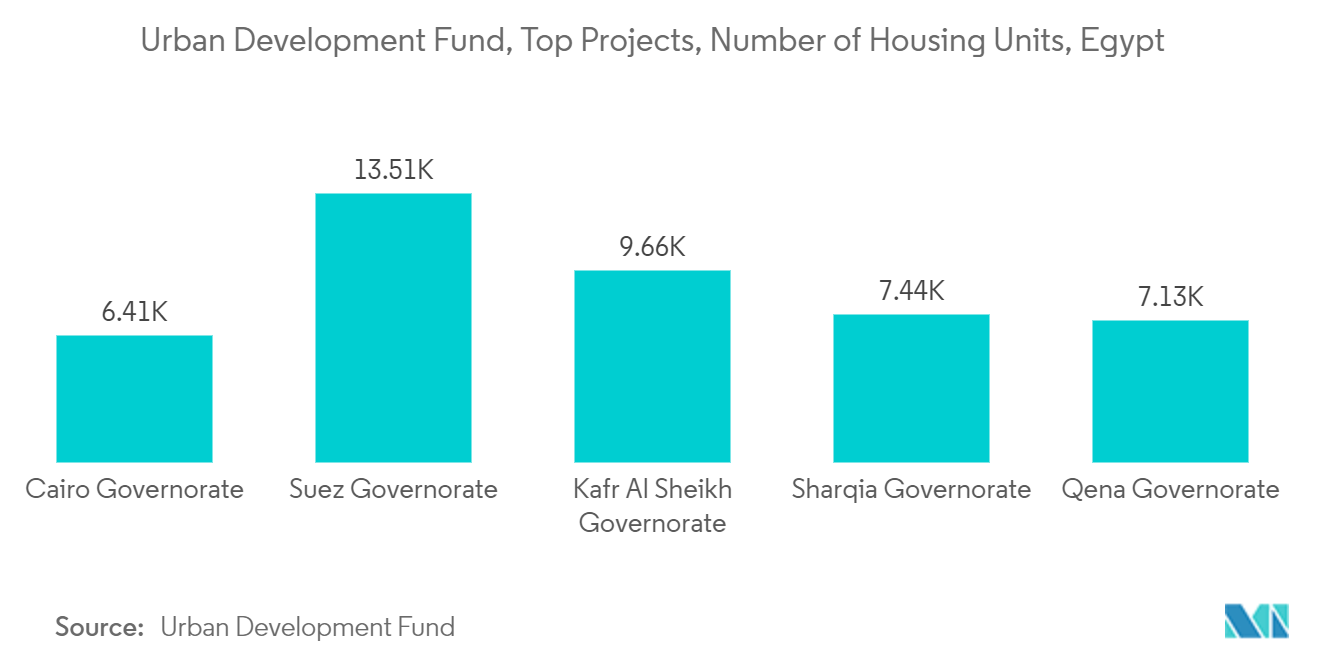
South Africa to Dominate the Regional Market
- South Africa is the largest construction market in the African region. It is home to a few green cement producers, such as Lafarge, a subsidiary of Holcim, PPC Cement, and Afrisam South Africa.
- The construction of green buildings has also been on the rise in the country, with a few investments and partnerships announced:
- In April 2022, the International Finance Corporation (IFC), the World Bank Group’s private sector financing division, granted a USD 38 million (ZAR 600 million) line of credit to Business Partners. This South African company financed and supported small and medium-sized enterprises (SMEs). The company was expected to provide loans of between ZAR 500,000 and ZAR 50 million (USD 31,000 and USD 3 million) to SMEs to construct green, certified commercial buildings and renovate existing commercial buildings in terms of energy consumption.
- In January 2022, The Green Building Council South Africa (GBCSA) and the UK-based Carbon Trust signed an agreement to improve buildings' energy efficiency in South Africa. The partnership between the two organizations is funded by the UK's Partnering for Accelerated Climate Transitions (PACT) program. The scheme is already being piloted in 30 South African buildings and is based on energy performance certificates (EPCs), a regulation that has been implemented since 2020.
- Moreover, residential and commercial construction in the country also showed positive growth in 2022. According to Statistics South Africa, the value of construction projects approved by the government has increased by 7.7% in 2022 overall.
- The value of residential construction projected accounted for the majority share with ZAR 62.2 billion (USD 3.33 billion), whereas non-residential construction accounted for a value of ZAR 22.1 billion (USD 1.19 billion). The value approved for additions and alterations in residential and non-residential buildings was ZAR 33.1 billion (USD 1.78 billion).
- In terms of growth, the non-residential recorded the highest growth with 17.2% followed by additions and alterations in residential and non-residential buildings with 11%.
- Overall, the outlook for the construction industry and green buildings appears to be positive and will complement the growth of green cement in the country.
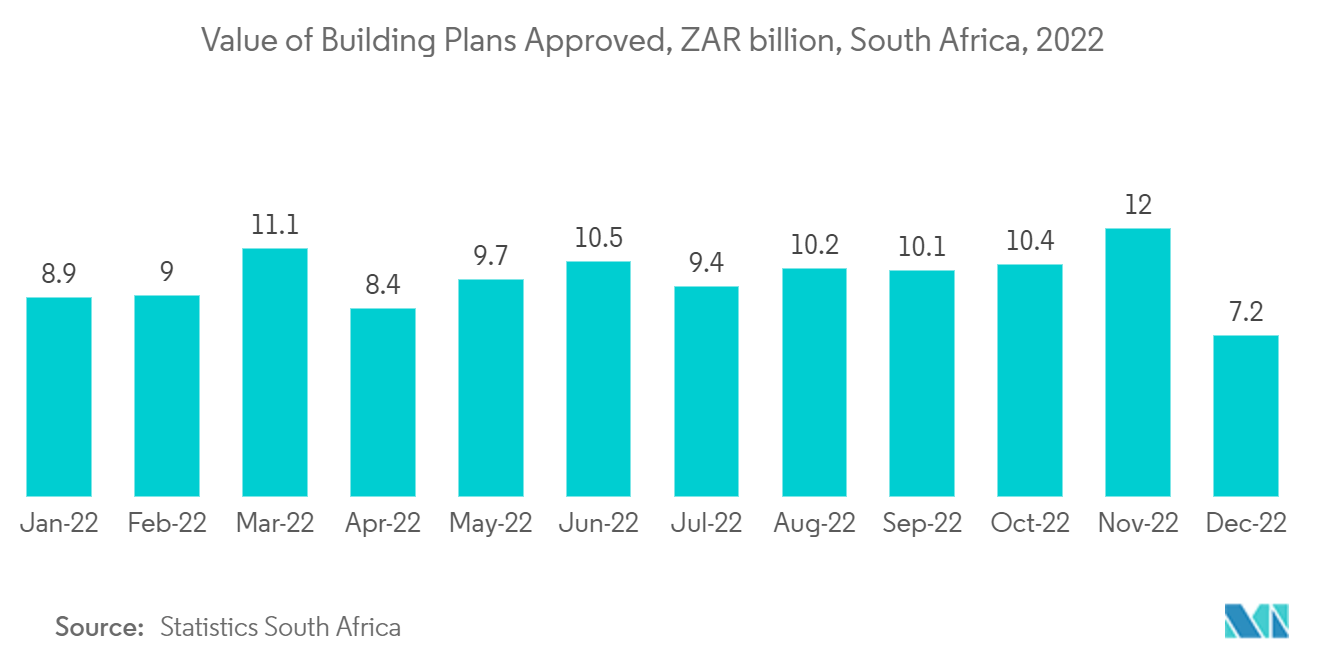
Competitive Landscape
The African green cement market is partially consolidated in nature. The major players (not in any particular order) include HOLCIM, AFRISAM, PPC Ltd., East African Portland Cement PLC, and Heidelberg Materials, among others.
Africa Green Cement Industry Leaders
HOLCIM
Heidelberg Materials
PPC Ltd.
AFRISAM
East African Portland Cement PLC
- *Disclaimer: Major Players sorted in no particular order
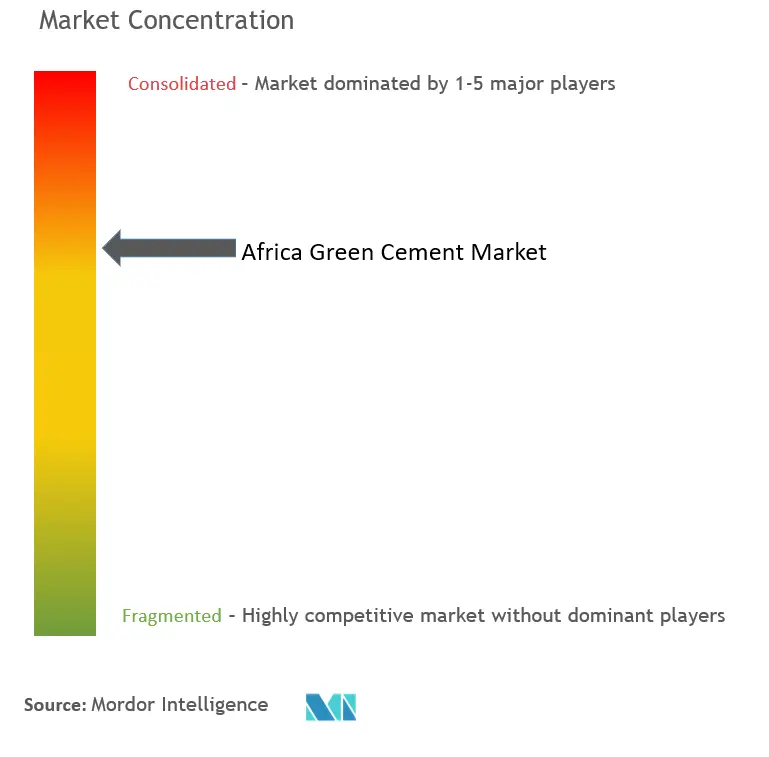
Recent Industry Developments
- January 2023: The East African Portland Cement (EAPC) revealed plans to expand within the East African Community member countries following its KES 500 million (USD 3424657.50) plant upgrade and the introduction of a new, cheaper Green Triangle cement brand.
- November 2022: East African Portland Cement Plc (EAP) launched a new product named Green Triangle Cement to minimize carbon emissions. In July 2022, the company refurbished its kiln at an investment of KES 0.5 billion (USD 4.11 million), enabling it to produce green cement.
- September 2022: The German building materials company formerly named HeidelbergCement was rebranded as Heidelberg Materials.
- July 2022: Lafarge South Africa, a subsidiary of Holcim Group, launched ECOPact cement, which is a green cement. The product launched by the company is available in variants containing between 30% and 100% less carbon emissions.
Africa Green Cement Market Report Scope
Green cement is an environmentally friendly cement that reduces carbon dioxide emissions during manufacturing. Green cement is mostly produced from raw materials that are discarded as waste from industrial processes. Some of the major raw materials for producing green cement include the slag from the blast furnace and fly ash. Magnesium oxychloride cement, calcium sulfoaluminate cement, geopolymer cement, and sequestrated carbon cement are some examples of green cement.
Africa's green cement market is segmented by product type, construction sector, and geography. By product type, the market is segmented into fly ash-based, slag-based, limestone-based, silica fume-based, and other product types (geopolymers and recycled aggregates). By the construction sector, the market is segmented into residential and non-residential. The report also covers the market size and forecasts for the African green cement market in 4 countries across the African region.
For each segment, the market sizing and forecasts have been done on the basis of volume (tons).
| Fly Ash-based |
| Slag-based |
| Limestone-based |
| Silica fume-based |
| Other Product Types (Geopolymers and Recycled Aggregates) |
| Residential |
| Non-residential |
| South Africa |
| Egypt |
| Algeria |
| Nigeria |
| Rest of Africa |
| Product Type | Fly Ash-based |
| Slag-based | |
| Limestone-based | |
| Silica fume-based | |
| Other Product Types (Geopolymers and Recycled Aggregates) | |
| Construction Sector | Residential |
| Non-residential | |
| Geography | South Africa |
| Egypt | |
| Algeria | |
| Nigeria | |
| Rest of Africa |
Key Questions Answered in the Report
How big is the Africa Green Cement Market?
The Africa Green Cement Market size is expected to reach 300.93 kilotons in 2025 and grow at a CAGR of greater than 6% to reach 402.72 kilotons by 2030.
What is the current Africa Green Cement Market size?
In 2025, the Africa Green Cement Market size is expected to reach 300.93 kilotons.
Who are the key players in Africa Green Cement Market?
HOLCIM, Heidelberg Materials, PPC Ltd., AFRISAM and East African Portland Cement PLC are the major companies operating in the Africa Green Cement Market.
What years does this Africa Green Cement Market cover, and what was the market size in 2024?
In 2024, the Africa Green Cement Market size was estimated at 282.87 kilotons. The report covers the Africa Green Cement Market historical market size for years: 2019, 2020, 2021, 2022, 2023 and 2024. The report also forecasts the Africa Green Cement Market size for years: 2025, 2026, 2027, 2028, 2029 and 2030.
Page last updated on:
Africa Green Cement Market Report
Statistics for the 2025 Africa Green Cement market share, size and revenue growth rate, created by Mordor Intelligence™ Industry Reports. Africa Green Cement analysis includes a market forecast outlook for 2025 to 2030 and historical overview. Get a sample of this industry analysis as a free report PDF download.
